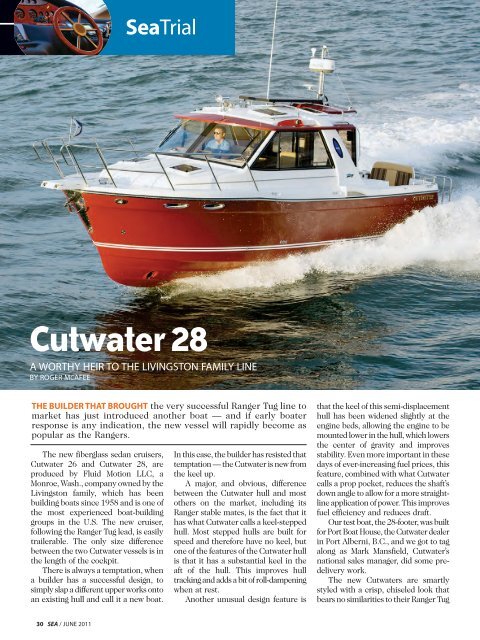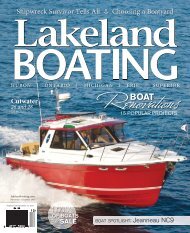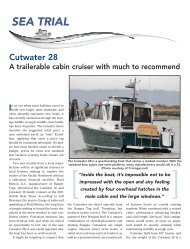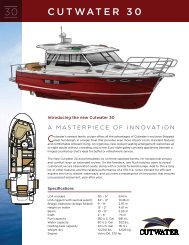You also want an ePaper? Increase the reach of your titles
YUMPU automatically turns print PDFs into web optimized ePapers that Google loves.
SeaTrial<br />
<strong>Cutwater</strong> <strong>28</strong><br />
A WORTHY HEIR TO THE LIVINGSTON FAMILY LINE<br />
BY ROGER MCAFEE<br />
THE BUILDER THAT BROUGHT the very successful Ranger Tug line to<br />
market has just introduced another boat — and if early boater<br />
response is any indication, the new vessel will rapidly become as<br />
popular as the Rangers.<br />
The new fiberglass sedan cruisers,<br />
<strong>Cutwater</strong> 26 and <strong>Cutwater</strong> <strong>28</strong>, are<br />
produced by Fluid Motion LLC, a<br />
Monroe, Wash., company owned by the<br />
Livingston family, which has been<br />
building boats since 1958 and is one of<br />
the most experienced boat-building<br />
groups in the U.S. The new cruiser,<br />
following the Ranger Tug lead, is easily<br />
trailerable. The only size difference<br />
between the two <strong>Cutwater</strong> vessels is in<br />
the length of the cockpit.<br />
There is always a temptation, when<br />
a builder has a successful design, to<br />
simply slap a different upper works onto<br />
an existing hull and call it a new boat.<br />
In this case, the builder has resisted that<br />
temptation — the <strong>Cutwater</strong> is new from<br />
the keel up.<br />
A major, and obvious, difference<br />
between the <strong>Cutwater</strong> hull and most<br />
others on the market, including its<br />
Ranger stable mates, is the fact that it<br />
has what <strong>Cutwater</strong> calls a keel-stepped<br />
hull. Most stepped hulls are built for<br />
speed and therefore have no keel, but<br />
one of the features of the <strong>Cutwater</strong> hull<br />
is that it has a substantial keel in the<br />
aft of the hull. This improves hull<br />
tracking and adds a bit of roll-dampening<br />
when at rest.<br />
Another unusual design feature is<br />
that the keel of this semi-displacement<br />
hull has been widened slightly at the<br />
engine beds, allowing the engine to be<br />
mounted lower in the hull, which lowers<br />
the center of gravity and improves<br />
stability. Even more important in these<br />
days of ever-increasing fuel prices, this<br />
feature, combined with what <strong>Cutwater</strong><br />
calls a prop pocket, reduces the shaft’s<br />
down angle to allow for a more straightline<br />
application of power. This improves<br />
fuel efficiency and reduces draft.<br />
Our test boat, the <strong>28</strong>-footer, was built<br />
for Port Boat House, the <strong>Cutwater</strong> dealer<br />
in Port Alberni, B.C., and we got to tag<br />
along as Mark Mansfield, <strong>Cutwater</strong>’s<br />
national sales manager, did some predelivery<br />
work.<br />
The new <strong>Cutwater</strong>s are smartly<br />
styled with a crisp, chiseled look that<br />
bears no similarities to their Ranger Tug<br />
30 SEA / JUNE 2011
ethren. The deckhouse of this sedan<br />
cruiser features windows all around.<br />
There is no glass print-through or<br />
hazing, and the hull sides of our test<br />
boat — hull number 3 — are fair and<br />
true. This is not surprising considering<br />
the builder’s decades of experience.<br />
Vessel access is through a starboard<br />
transom door off a swim grid. The grid<br />
itself is positioned at exactly the right<br />
height above the waterline, making it<br />
an easy and safe step from a floating<br />
dock. This is an important feature for<br />
boaters with small children or aging<br />
parents.<br />
An obvious feature in the transom<br />
is the reversible, comfortably padded<br />
seat that in good weather makes the<br />
self-bailing cockpit a great place to<br />
congregate. The cockpit is fishing<br />
friendly — no floor-mounted cleats or<br />
other toe-stubbers. While the cockpit<br />
sides are high enough to be safe and<br />
secure, the opening transom gate and<br />
large swim grid will make landing a<br />
large fish easy. Should, by accident,<br />
an angler slip off the swim grid<br />
(something many serious anglers have<br />
done, or is it only me), the built-in<br />
boarding ladder can be quickly<br />
deployed. Our test boat is equipped<br />
with the optional cockpit throttle and<br />
steering controls — useful while<br />
fishing or docking, or during closequarter<br />
maneuvering in crowded<br />
marinas.<br />
The cockpit has a freshwater sink<br />
and shower, a space for a cooler and<br />
an optional barbecue. It also includes<br />
the electric/hydraulic engine cover<br />
hatch in the sole, which gives full access<br />
to the engine and gear when it’s open.<br />
Access to the foredeck is along the<br />
narrow sidedeck, using grabrails on the<br />
salon roof. The foredeck itself features<br />
substantial handrails and a bow<br />
platform with a ladder that allows<br />
beach access over the bow.<br />
An Inside Look<br />
The traditionally<br />
laid-out boat packs<br />
a lot of comfort into<br />
a trailerable<br />
package.<br />
TESTER’S OPINION<br />
“The new <strong>Cutwater</strong>s are<br />
smartly styled with a crisp,<br />
chiseled look that bears no<br />
similarities to their Ranger Tug<br />
brethren.”<br />
COMFY CONFINES<br />
Access to the deckhouse is through<br />
an aluminum-framed glass door leading<br />
to a traditionally laid-out main salon<br />
— a port-side galley complete with a<br />
microwave/convection oven, a double<br />
stainless sink and a refrigerator/freezer,<br />
and a convertible settee/dinette to<br />
starboard. Forward of the galley is a<br />
mate’s seat, and forward of the dinette<br />
is a double helm seat with a wine cooler<br />
underneath. When the vessel is not<br />
under way, the back of both of these<br />
seats pivots forward to increase the<br />
usable galley countertop and settee<br />
space. There is also a 7-foot double berth<br />
under the dinette, but it’s rather<br />
cramped. However, the space would be<br />
great for storage.<br />
The deckhouse of the new <strong>Cutwater</strong><br />
contains more window glass than<br />
fiberglass, and that makes for an<br />
interior flooded with natural light. The<br />
roof of the salon contains four opening<br />
glass hatches, and even on a dull day<br />
SEAMAGAZINE.COM 31
<strong>Cutwater</strong><br />
<strong>28</strong><br />
SPECIFICATIONS<br />
LOA (rigged swim step, pulpit) 32 ft., 4 in.<br />
Bridge clearance (mast folded) 9 ft., 1 in.<br />
Beam<br />
8 ft., 6 in.<br />
Draft<br />
2 ft., 4 in.<br />
Fuel<br />
100 gals.<br />
Water<br />
40 gals.<br />
Holding<br />
30 gals.<br />
Weight (dry)<br />
6,400 lbs.<br />
Engine<br />
Yanmar 6BY2, 260 hp<br />
Base Price $169,937<br />
STANDARD EQUIPMENT<br />
See dealer for a complete list, as it is being<br />
modified with new builds.<br />
OPTIONAL EQUIPMENT<br />
Aft canopy Bimini top; aft side enclosures; aft<br />
steering station w/electronic controls; air<br />
conditioning w/reverse-cycle 16,000 BTU heat;<br />
anchor package; autopilot; CG safety kit;<br />
cockpit carpet; Wallas diesel stove/heater;<br />
Mase 2.7 kw generator; macerator discharge<br />
w/Y-valve; Garmin navigation package; solar<br />
panel, 135 watts w/controller; thruster wireless<br />
remote; transom platform (swim step) rails<br />
w/gate.<br />
BUILDER<br />
CUTWATER BOATS, Monroe, Wash.; (800)<br />
349-7198; cutwaterboats.com<br />
WEST COAST DEALERS<br />
<strong>Cutwater</strong> <strong>Boats</strong>, Monroe, Wash.; (800) 349-<br />
7198; cutwaterboats.com<br />
Port Boat House Ltd., Port Alberni, B.C.; (877)<br />
<strong>28</strong>3-BOAT; portboathouse.com<br />
SPECIFICATIONS<br />
<strong>Cutwater</strong> 26<br />
LOA rigged (swim step, pulpit) 30 ft., 1 in.<br />
Bridge clearance (mast folded) 9 ft., 1 in.<br />
Beam<br />
8 ft., 6 in.<br />
Draft<br />
2 ft., 4 in.<br />
Fuel<br />
80 gals.<br />
Water<br />
40 gals.<br />
Holding<br />
30 gals.<br />
Weight (dry)<br />
5,900 lbs.<br />
Engine<br />
Yanmar 6BY2, 180 hp<br />
Base Price $139,937<br />
there’s plenty of natural light inside. The<br />
opening roof hatches also help with<br />
ventilation.<br />
In fact, the aft pair of roof hatches<br />
on our test boat have two features that<br />
will allow the vessel to ventilate very<br />
well, even when it’s running in the rain<br />
or punching into a head sea. They are<br />
both hinged at the forward edge, which<br />
means the opening is aft. This prevents<br />
water from being scooped in as the vessel<br />
is running. The second feature is that<br />
the hatch itself can be dogged open only<br />
very slightly, to allow a breeze to blow<br />
through while not allowing water to<br />
enter. This hatch represents a major<br />
step forward in small-boat ventilation.<br />
Forward and down two steps is the<br />
forecastle, with a couple of features not<br />
found on any other boat in this market<br />
segment. The first, and most obvious,<br />
is what <strong>Cutwater</strong> calls a breakfast bar,<br />
containing a stainless sink, a microwave<br />
and a coffeemaker. While this may be<br />
perceived by some as merely a sales<br />
tool, experienced cruisers know that if<br />
someone is sleeping on the convertible<br />
dinette, making even a cup of coffee in<br />
the morning is a problem.<br />
The forward double berth converts<br />
to seating for four people around a highlow<br />
table that is part of the berth base<br />
when the area is set up as the master<br />
stateroom. A full standup private head,<br />
complete with a sink, a hot- and coldwater<br />
shower, and an electric flush toilet,<br />
is to starboard, and it is where the boat’s<br />
second unusual feature is found. The<br />
head, though located directly under the<br />
dash, as is normal in vessels this size,<br />
boasts a skylight that brings natural light<br />
into the head space through a frostedglass<br />
panel in the ceiling.<br />
The glass panel is located in the main<br />
salon dash, just ahead of the helm station<br />
and inside the windshield. Light pouring<br />
in the windshield floods the head with<br />
light through the panel. This is a very<br />
effective method of getting natural light<br />
into what is normally a rather dark space<br />
if the lights are not turned on. The only<br />
other new vessel using this feature to<br />
bring natural light belowdecks is much<br />
bigger and costs almost a million<br />
dollars.<br />
UNDER WAY<br />
We fired up the diesel engine, and<br />
with a touch of the bow and stern<br />
thrusters, both standard on <strong>Cutwater</strong>s,<br />
we eased away from the dock. The main<br />
engine, a Yanmar 6BY2, 260 hp, started<br />
easily without even a wisp of smoke.<br />
This 183-cubic-inch, 694-pound,<br />
common-rail engine ran smoothly and<br />
quietly on startup and performed well<br />
during our test.<br />
We idled away from the dock at 670<br />
rpm making 3.9 knots and burning 0.3<br />
gallons of diesel per hour. The ability<br />
of a vessel to proceed at a relatively slow<br />
speed with precise control in crowded<br />
marinas is very important, and the<br />
<strong>Cutwater</strong>s, complete with bow and stern<br />
thrusters, will perform that job very well.<br />
At 1000 rpm, we made 5.4 knots<br />
and sipped 0.6 gph. Even with the aft<br />
door open, the noise level was only 67<br />
decibels. At 2000 rpm, we burned 3 gph<br />
and made 9 knots. At 3000 rpm, we<br />
made 18.6 knots and burned 6.6 gph,<br />
while 3500 rpm brought 23.1 knots with<br />
a fuel burn of 10.6 gph. WOT, about<br />
4080 rpm, had us scooting along at <strong>28</strong>.2<br />
knots and burning 13.4 gph. All speeds<br />
were measured by GPS, and fuelconsumption<br />
figures were generated by<br />
the engine’s onboard computer.<br />
The vessel tracked well and<br />
responded smartly and precisely to the<br />
helm at all speeds. We laid beam on close<br />
to a passing ferry wake, and the vessel<br />
handled that very well. We then<br />
pounded through the wake at speed,<br />
and the <strong>28</strong>-footer had no problem. In<br />
tight turns, the vessel stuck well without<br />
skidding or skipping. At all speeds and<br />
under all our test conditions, the vessel<br />
exhibited no bad habits.<br />
While this is a good vessel, there are<br />
a couple of improvements that could<br />
easily be made. More handrails inside<br />
would be welcome, and many cruisers<br />
would like more fuel capacity — 100<br />
gallons is too limiting for such a good<br />
cruising boat.<br />
If you want a solid boat made by a<br />
pedigreed U.S. builder, <strong>Cutwater</strong> is worth<br />
a look. It handles well, is very<br />
comfortable and is economical to<br />
operate. At 9 knots (10.3 mph), it gets<br />
3 mpg. It has plenty of space inside, a<br />
good usable cockpit and has the speed<br />
necessary to outrun the weather. And<br />
while it’s at home in a marina slip, it is<br />
fully trailerable, nicely styled and well<br />
fitted out. At a price of $169,937, it is<br />
an excellent value.<br />
32 SEA / JUNE 2011






